Jupiter
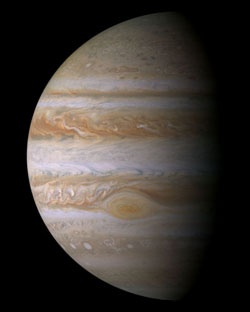
Everything about Jupiter is BIG. Jupiter’s mass is more than 300 times that of Earth, and more than three times that of the second largest planet, Saturn. If all the planets except Jupiter were rolled into one gigantic superplanet, Jupiter would still be king.
Jupiter has more than 60 moons. Three of these are larger than Earth’s moon, and one is larger than the planet Mercury! Jupiter’s magnetic field is the largest planetary structure in the Solar System, extending beyond the orbit of Saturn.
Jupiter Facts:
Average distance from Sun: 800 million km
Orbital period: 12 Earth years
Rotation period: 10 hours
Diameter at equator: 11 x Earth’s
Mass: 320 x Earth’s
Tilt of axis: 3°
Number of moons: More than 60
Number of rings: At least 3
What Would Happen if You Plunged into a Giant Planet?
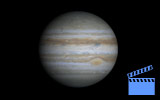 Earth's atmosphere is a relatively minor feature of our planet. It hugs the surface and thins out to almost nothing at an altitude of about 100 kilometers. By contrast, Jupiter’s atmosphere is tens of thousands of kilometers thick, and there is no solid surface to stand on. You might say that Jupiter is all atmosphere.
Earth's atmosphere is a relatively minor feature of our planet. It hugs the surface and thins out to almost nothing at an altitude of about 100 kilometers. By contrast, Jupiter’s atmosphere is tens of thousands of kilometers thick, and there is no solid surface to stand on. You might say that Jupiter is all atmosphere.
What would you encounter if you descended into Jupiter? The air pressure near the cloud tops is roughly the same as at Earth’s surface. But it increases dramatically as you drop, and so does the temperature. Assuming you could survive the trip, you would fall through thickening air, crushing pressure, and searing heat. The mostly hydrogen gas would gradually become as thick as pudding. Deep inside the planet, the tremendous pressure creates a form of hydrogen that conducts electricity like a metal. Still lower, you reach a solid core larger than Earth.
Probing the Great Red Spot
More than just a pretty picture – an image is a scientific tool
When you put your eye to a telescope and gaze at Jupiter, you see it in visible light. Other wavelengths beyond visible reveal additional information about the planet. Astronomers use cameras with special detectors to record this information. They assign “false colors” to different wavelengths in these images to highlight different details.
How many Earths can fit inside Jupiter’s Great Red Spot?
Meet the Moons
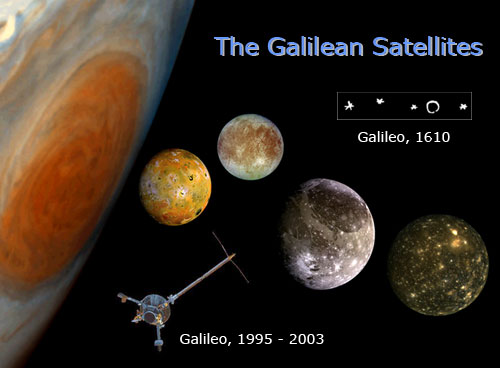
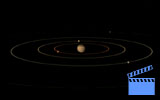 Jupiter's many moons range in size from rocky bodies only a few kilometers across to one that is larger than Mercury. New moons are being found all the time. The four largest, in order of distance from Jupiter, are Io, Europa, Ganymede, and Callisto – known as the Galilean satellites because of their discovery by the astronomer Galileo in 1610. From 1995 to 2002, a spacecraft named Galileo made some of our most spectacular pictures of these worlds.
Jupiter's many moons range in size from rocky bodies only a few kilometers across to one that is larger than Mercury. New moons are being found all the time. The four largest, in order of distance from Jupiter, are Io, Europa, Ganymede, and Callisto – known as the Galilean satellites because of their discovery by the astronomer Galileo in 1610. From 1995 to 2002, a spacecraft named Galileo made some of our most spectacular pictures of these worlds.
 Europa
Europa, with an ocean of liquid water beneath a smooth ice crust.
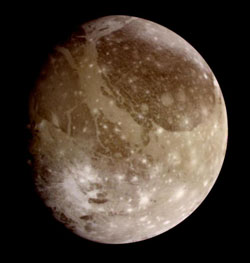 Ganymede
Ganymede, the largest moon in the Solar System.
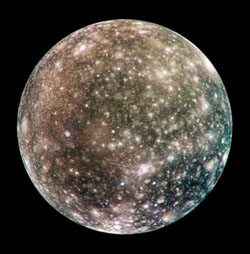 Callisto
Callisto, the most heavily cratered world in the Solar System.
Moon Dance
An intricate ballet heats things up
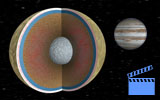 Why is Jupiter’s moon, Io, the most volcanically active world in the Solar System? Io’s core should have cooled off long ago. But this little moon is kept hot by a combination of gravitational influenced from Jupiter and two of Jupiter’s other large satellites.
Why is Jupiter’s moon, Io, the most volcanically active world in the Solar System? Io’s core should have cooled off long ago. But this little moon is kept hot by a combination of gravitational influenced from Jupiter and two of Jupiter’s other large satellites.
Here's how it works: Over time, Io, Europa, and Ganymede have developed an orbital relationship called a resonance, which periodically pulls Io farther away from Jupiter. Then Jupiter pulls Io back. The result is that Jupiter’s powerful gravity causes tidal effects on Io that are sometimes weaker, sometimes stronger. Something similar happens when you flex and unflex a piece of plastic: very soon it heats up! On Io, the “flex” heating is enough to melt a portion of the interior and cause constant volcanic eruptions.
Exploring the Giant Magnetosphere of Jupiter
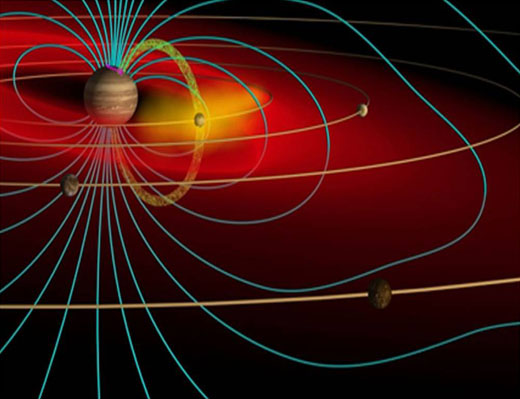
Earth

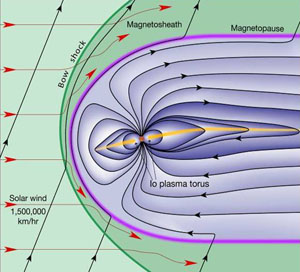 Jupiter's strong magnetic field makes a vast magnetosphere.
Jupiter's strong magnetic field makes a vast magnetosphere.
1,000 Suns would fit inside Jupiter's magnetosphere
Jupiter's 3 Types of Aurora
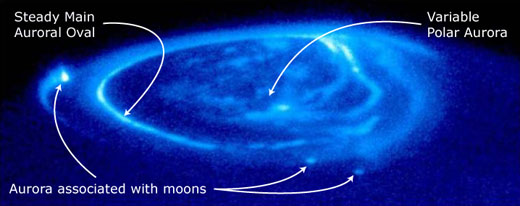
Our Sharpening Picture of Jupiter
With the unaided eye, Jupiter looks like a bright star. The first person to study it with a telescope was Galileo in 1610. Half a century later, bigger telescopes showed cloud bands and the Great Red Spot. The first spacecraft to visit Jupiter flew by in 1973. Since then, more probes have inspected the planet up close. In recent years, telescopes based on Earth and in space have also viewed Jupiter in remarkably sharp detail.
1610 – Galileo makes the first drawings of Jupiter and its four larges moons.
1656 – Christiann Huygens records bands on Jupiter
1973 – Pioneer 10 becomes the first space probe to fly past Jupiter
1979 – Voyager 1 passes Jupiter, taking thousands of pictures of the planet and its moons.
1994 – The Hubble Space Telescope captures the aftermath of comet strikes on Jupiter.
1996 – Galileo probe becomes the first spacecraft to orbit Jupiter
2000 – Cassini spacecraft passes Jupiter on its way to Saturn.



